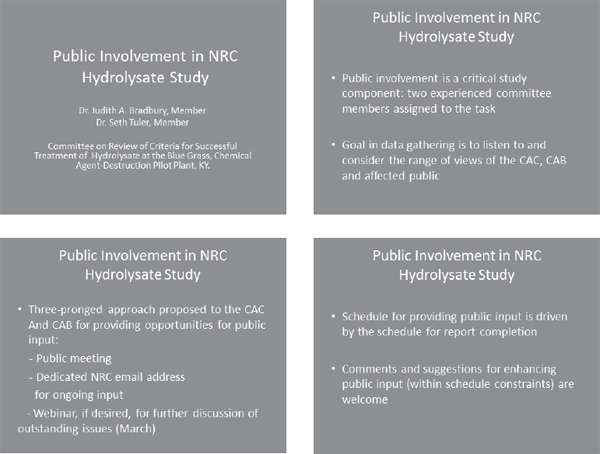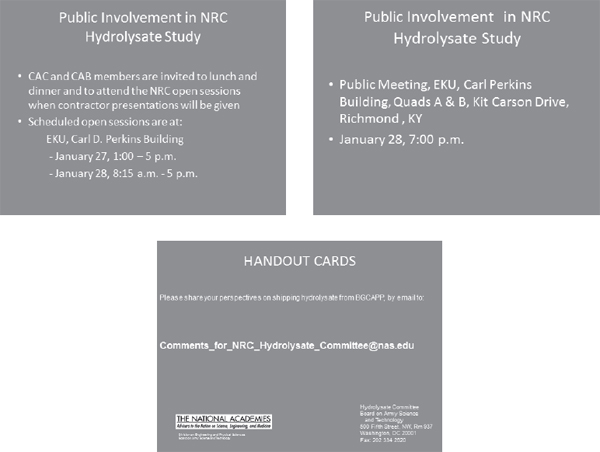B
Public Interest and Input Documents

Exhibit 1. Committee approach to encouraging public input. Presented at committee meeting on January 29, 2015.
(Exhibit continues on next page.)

1/21/2015 NRC seeks public comment on hydrolysate transport Richmond Register: News
NRC seeks public comment on hydrolysate transport
Special to the Register | Posted: Wednesday, January 21, 2015 7:30 pm
A National Research Council (NRC) committee is seeking public comment regarding the potential for the shipment of hydrolysate from the Blue Grass Chemical Agent Destruction Pilot Plant after chemical weapons agents are destroyed.
Datagathering sessions will be conducted at the Eastern Kentucky University Perkings Building from 1 to 5 p.m. Tuesday and Wednesday from 8 a.m. to 5 p.m. A public comment session is scheduled for 7 p.m. Wednesday.
During the two daytime sessions, the committee will hear presentations from and hold discussions with government BGCAPP personnel; the contractor, Bechtel Parsons; personnel from the Kentucky Department for Environmental Protection, and representatives of the Citizens’ Advisory Commission and the Community Advisory Board.
In addition, the committee has established a dedicated email address for receiving public comments: Comments_for_NRC_Hydrolysate_Committee@nas.edu.
The plant is designed to destroy the stockpile of chemical weapons stored at the Army’s Blue Grass Army Depot.
Hydrolysate is the waste product that remains following the chemical destruction by hydrolysis of the chemical agents and energetics.
The Program Manager for Assembled Chemical Weapons Alternatives has tasked the NRC committe e to independently develop criteria for safely and successfully treating the hydrolysate that will be produced at BGCAPP, and, if the supercritical water oxidation system underperforms in treating hydrolysate, to identify potential modifications that would allow continued onsite processing, as well as regulatory requirements for offsite hydrolysate and treatment options.
“Part of our tasking is to consider stakeholder interests and solicit stakeholder input,” said committee chair Todd A. Kimmell, principal investigator with the Environmental Science Division at Argonne National Laboratory. “We want to understand the perspectives of the people who live in the surrounding area and who work at BGCAPP.”
Exhibit 2. Article from Richmond Register website, January 21, 2015, announcing committee meeting, public meeting, and e-mail address for submitting public comments to the committee.
From: Doug Hindman
Sent: Tuesday, February 03, 2015 5:37 PM
To: Hydrolysate Committee
Subject: Hydrolysate comment
As chair of the KY CAC I was privileged to address your committee and to attend at least part of your Kentucky meeting.
I’m concerned that your committee is unduly restricting the options you are considering. Your statement of task asks you “to identify potential modifications that would allow continued onsite processing.” The only potential modification I heard addressed was off-site transportation. In fact, your card seeking public comment asks for perspectives only on this option. While it’s an obvious option, I hope your committee will also consider other, especially on-site, options.
For example, I asked you to consider use of the EDT presently under construction at Kentucky’s pilot plant. This EDT will be a one-step treatment for mustard-filled projectiles that should finish before the main plant begins. Thus it could be available to treat “excess” hydrolysate if the SCWO system develops problems.
I do not expect your committee to evaluate such options in detail. I urge you to identify possible on-site options, such as EDT, for more detailed evaluation by ACWA.
Thanks to your committee for your efforts.
Douglas Hindman
Exhibit 3. E-mail from Douglas Hindman, Chair, Kentucky Citizens’ Advisory Commission, on February 3, 2015.
|
|
Chemical Demilitarization Citizens’ Advisory Commission |
 |
|
Doug Hindman |
|
Reagan Taylor Craig Williams Co-Chairs |
|
NRC Hydrolysate Committee |
March 2, 2015 |
|||
Dear Committee Members,
Herein please find the salient points raised during your Committee meeting held in Richmond, Kentucky in January of this year.
Again, please accept our appreciation for holding the meeting here in the affected community.
OVERARCHING POSITIONS
1) This study is being undertaken strictly as a contingency plan should hydrolysate secondary waste processing problems necessitate off-site shipment; and
2) Every opportunity for CAC/CDCAB involvement and input should be provided and welcome.
SUGGESTED CRITERIA
IF secondary treatment of hydrolysate is unable to keep up with neutralization output (due to unexpected processing limitations with the SCWO system, etc.);
AND if all feasible mitigation measures have been evaluated;
AND if mitigation is impossible or would require that plant operations be suspended for an extensive period of time. (“Extensive” should be defined within the Study)
THEN alternative approaches (“Plan B”) would be acceptable BUT ONLY for that portion of the neutralization output that cannot be processed through the planned secondary treatment and/or stored on site until mitigation is achieved. It’s easy to conceive that problems may be temporary or limited so that only part of the hydrolysate would need transportation).
ALSO, The NRC should consider alternative on-site treatment possibilities. For example, it might be possible to modify the EDT to process “excess” hydrolysate.
SUGGESTED STUDY ELEMENTS
It is our expectation that the NRC will:
Exhibit 4. Statement from the Kentucky Citizens’ Advisory Commission and Chemical Destruction Community Advisory Board, March 2, 2015.
(Exhibit continues on next page.)
- Highlight at the BEGINNING of the report that the effort is being made only as a contingency in the event that the on-site treatment reaches a point where there is NO OTHER OPTION than to ship off-site.
- Work with ACWA, BPBG, KDEP, CAC/CDCAB, and BGAD to develop a set of protocols that will identify under what circumstances off-site shipment would occur. These should include the study objectives in the Statement of Task and also include, but not be limited to:
• Consideration of the historical position of the CAC/CDCAB and reception communities of p ast agent hydrolysate shipments;
• Identification of technology and location of any potential reception site/community;
• Consideration of schedule impact via opposition (regulatory, legal, political) from identified potential reception site(s);
• Developing a means of information sharing and input from the CAC/CDCAB as items identified in the Statement of Task are evolving. (i.e. storage levels identified that might be a threshold to trigger shipment);
• Providing certain CAC/CDCAB members review in draft form opportunities in accordance with procedures approved by the NRC Report Review Committee, similar to the Citizens Advisory Technical Team (CATT) associated with the ACWA Dialogue.
Sincerely,
|
Doug Hindman |
Craig Williams |
|
Doug Hindman |
Craig Williams |







